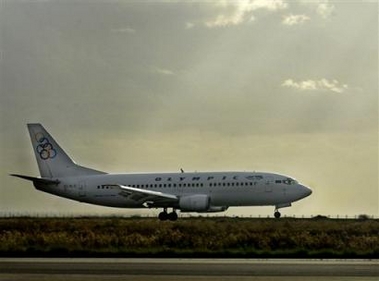|
Flight attendant tried to save doomed Cypriot plane
(AP)
Updated: 2005-12-20 09:42
A flight attendant tried to save a Cypriot airliner that crashed near Athens
earlier this year, wrestling with controls for at least 10 minutes before the
Helios Airways flight went down, investigators said Monday.
All 121 people on board were killed when the Boeing 737-300 slammed into a
hillside on Aug. 14. The plane apparently lost cabin pressure, incapacitating
the pilots, and eventually ran out of fuel.
Investigators Monday carried out a re-enactment of Flight 522 from Larnaca,
Cyprus to Athens, to analyze the causes of Greece's worst air disaster.

The boeing 737-300 of Greek Olympic ariways is
seen before taking off from Cyprus to re-enact the course of a Cypriot
airliner that crashed near Athens on Aug. 14, killing all 121 people on
board, in Larnaca international airport in southern Cyprus 45 kilometers
(28 miles) from the capital of Nicosia on Monday, Dec. 19, 2005.
[AP] | Senior investigator Serafeim Kamoutsis said
25-year-old Cypriot flight attendant Andreas Prodromou entered the cockpit at
least 10 minutes before the crash, while the plane was in a holding pattern and
the pilots were unconscious or partially conscious.
"He tried to fly the plane manually as best as he could," Kamoutsis said,
adding that it was too early to comment on how the automatic pilot was disabled.
Kamoutsis declined to say how investigators know the flight attendant tried
to fly the plane. He said Prodromou, who had some pilot training, opened the
cockpit door after entering the security code about 10 to 12 minutes before the
crash.
Chief investigator Akrivos Tsolakis said he believed the Cypriot airliner
suffered a "partial and not total loss of pressure" and that the flight
attendant remained conscious because he found a portable supply of oxygen.
"This (loss of pressure) occurred during the ascent ... We are still
investigating why the pilots continued their ascent and did not respond
properly," Tsolakis said.
He said investigators suspected that a switch controlling the pressure had
been placed on the wrong setting, but cautioned that this fact alone was not
enough to explain the accident.
Last month, Tsolakis said he believed "human factors" were "broadly
responsible" for the crash, but did not elaborate.
In Monday's re-enactment, special Olympic Airways flight 121 �� named in honor
of the victims �� traced the route of the low-cost Cypriot airline from Larnaca
and circled around the Aegean Sea island of Kea as jets followed behind and
videotaped the flight.
Greek investigators are due to issue their first report in February, but
their findings will not be made public until June, pending recommendations from
other investigative agencies and Boeing.
|